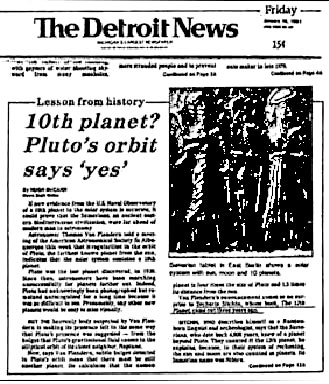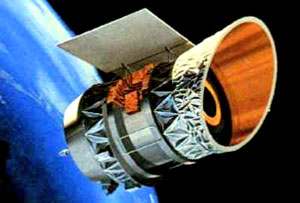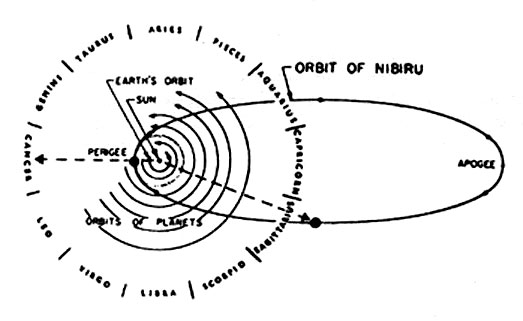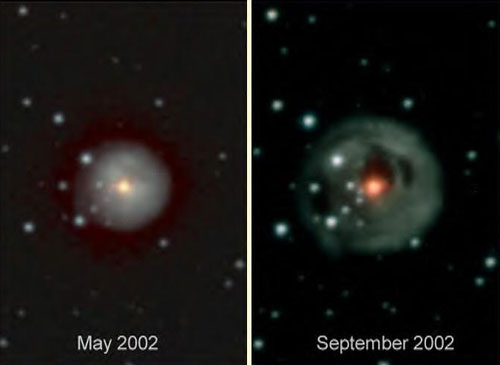|

por starviwer
9 Agosto 2009
del Sitio Web
StarViewer
El presente artículo de investigación, está basado y contrastado con
todos los datos disponibles procedentes de fuentes oficiales, y
demuestra que desde 1983, ya se tiene conocimiento de la existencia
de una enana marrón que orbita nuestro sistema solar.
Claramente podemos distinguir tres etapas:
-
(1981-1989),
corresponde a la etapa del descubrimiento
-
(1990-2002), la etapa del
estudio científico y publicación Oficial
-
(2003-2009), la etapa de la
censura y ocultación de resultados
1. La etapa del descubrimiento (1981-1989)
Tras completar, el modelo orbital del sistema solar, y encajar los
datos a la luz de las sondas de exploración espacial, aparece en la
prensa un interesante artículo en 1981, “The Detroit News”

The Detroit News-1981
En él se reflexiona sobre la evidencia histórica del conocimiento
que los sumerios, tenían de nuestro sistema solar, especialmente
debido a que los recientes hallazgos científicos, configuraban parte
del mapa de nuestro sistema solar, y por aquella época (1981), los
conocimientos de la nube de Kuiper-oort,eran aún muy limitados.
En
aquél momento, se configuraba la idea por los astrónomos, de que
había que localizar más objetos, aún más alejados de Plutón, pues la
órbita de Éste, así como la de los planetas Urano y Neptuno,
presentaban alteraciones que únicamente parecían explicarse por la
existencia de otros planetas más allá de la órbita de Plutón.
Y sí fue.
En 1983, el telescopio IRAS, un potente telescopio de
Infrarrojos, en 1984, descubrió la perturbación de Oort, y la
presencia de un grupo de objetos, relativamente próximos, que
formaban parte de nuestro sistema solar.

IRAS-TELESCOPE
EL 31 de Diciembre de 1983, el diario “Washington Post”, publicó en
su portada el descubrimiento con un gran titular que decía, "Mystery Heavenly Body Discovered"
y citaba textualmente:
A heavenly body possibly as large as the giant planet Jupiter and
possibly so close to Earth that it would be part of this solar
system has been found in the direction of the constellation Orion by
an orbiting telescope aboard the U.S. infrared astronomical
satellite.
So mysterious is the object that astronomers do not know
if it is a planet, a giant comet, a nearby “protostar” that never
got hot enough to become a star, a distant galaxy so young that it
is still in the process of forming its first stars or a galaxy so
shrouded in dust that none of the light cast by its stars ever gets
through.
“All I can tell you is that we don’t know what it is,” Dr.
Gerry Neugebauer, IRAS chief scientist for California’s Jet
Propulsion Laboratory and director of the Palomar Observatory for
the California Institute of Technology said in an interview.
Pueden leer el texto completo
aquí.
En aquél momento, se determinaron los datos necesarios para
continuar con una nueva línea de investigación, basada en la
observación, las órbitas, y el análisis de tallado de las
perturbaciones en Oort.
Ésta detección y la investigación preliminar, concluyó en 1989, con
la publicación en 1991 de un informe científico de la Universidad de
Harvard, en el que, se calculaba, que la perturbación venía de la
zona de Sagitario, y con toda seguridad, se trataba de una enana
marrón, un nuevo tipo de cuerpo estelar, hasta entonces desconocido.
En dicho informe, aparece expresamente el siguiente esquema:

Primer esquema original relativo a la perturbación en Sagitario.
Obsérvese claramente, cómo ya en 1989-1991, se conocía exactamente
la existencia de una enana marrón, que estaba causando
perturbaciones en el sistema solar, y que orbitaba éste.
A partir de ese momento, comienza la fase 2.
2. La etapa de investigación, simulación orbital y estudio del
impulso orbital del objeto (1989-2002)
En esta etapa, un comité de expertos, encabezados inicialmente por
J.Matese y J.Murray, comienzan la investigación profunda del nuevo
hallazgo, y con fecha de Octubre de 1999, concluye textualmente:
Planetary Systems in the Universe
- Observation, Formation and
Evolution
ASP Conference Series, Vol.
A.J. Penny, P. Artymowicz, A.-M. Lagrange, and S.S. Russell, eds.
3 108, 1999
Supportive Evidence for a Brown Dwarf Solar Companion
by
John J. Matese
University of Louisiana at Lafayette, Lafayette LA USA 70504-4210
Abstract
Comet orbital elements which suggested that there may be a
Jovian-mass
brown dwarf in our solar system. An extended cometary database is
now available. The analyses have been repeated and we find that the
set of statistically significant correlated anomalies is enhanced. We
also
respond to unsupported objections that have been raised to this
conjecture. If real, the wide-binary object would constitute a natural
dynamical
intermediary between gas giant planetary objects and isolated
objects.
We have previously given evidence based on Oort cloud.
Obviamente, dicho informe fue dirigido y encargado por la
NASA, y
acompañado de una carta del Dr. Matese:
En aquél momento, se crea un comité de investigación denominado
ICARUS, cuyo objetivo consiste en el detallado conocimiento de la
órbita de la Enana Marrón y las consiguientes perturbaciones en
sagitario.
Este comité dirigido por J.Matese, al que posteriormente
se incorporan otros importantes astrofísicos como el Dr. Lissauer.
Dicha investigación concluye en 2002, y consiguen definir el
denominado Impulso estelar, y publican el informe LMM, estimando
dicho impulso en un 41% como causa de la perturbación Oort.
Dicho
estudio es el más completo realizado por la comunidad científica, y
en cuya base nos hemos fundamentado en el cálculo de la
Hoja de Trabajo N-II.
Una vez, expuesto lo anterior, con fecha de 7 de Octubre de 1999, el
editor científico de la revista NBC, Mr. Alan Boyle, publica un
artículo en la sección ciencia, que dice textualmente:
A Mystery Revolves Around The Sun
Scientists suggest huge unseen
object orbits on fringe of solar system
Oct. 7, 1999 – Two teams of researchers have proposed the existence
of an unseen planet or a failed star circling the sun at a distance
of more than 2 trillion miles, far beyond the orbits of the nine
known planets. The theory, which seeks to explain patterns in
comets’ paths, has been put forward in research accepted for
publication in two separate journals.
Speculation about the existence
of unseen celestial companions dates back far before the discovery
of Pluto in 1930 — and even figures in more recent fringe phenomena
such as the 1997 “Heaven’s Gate” tragedy and talk of a new “Planet
X.” This latest hypothesis, however, is aimed at answering nagging
scientific questions about how particular types of comets make their
way into the inner solar system.
Some comets, like Halley’s Comet, follow relatively short-period
orbits - circling the sun in less than two hundred years. These
comets are thought to originate in the Kuiper Belt, a disk of cosmic
debris that lies beyond Neptune’s orbit.
Pero, este hallazgo no se limita únicamente a este medio, sino que
igualmente, con idéntica fecha, la evidencia se publica por Harvard,
por lo que la nota de prensa está apoyada en el estudio realizado y
publicado por dicha Universidad, constituyendo ciencia y es Público
y elevado a un evento Oficial.
Y textualmente reproducimos:
Title:
Cometary Evidence of a Massive Body in the Outer Oort Clouds
Authors: Matese, J. J.; Whitman, P. G.; Whitmire, D. P.
Affiliation: AA(), AB(Department of Physics, University of Louisiana
at Lafayette, Lafayette, Louisiana), AC(Department of Physics,
University of Louisiana at Lafayette, Lafayette, Louisiana)
Publication: Icarus, Volume 141, Issue Icarus, pp. 354-366. (Icarus
Homepage)
Publication Date: 10/1999
Origin: ICAR
Abstract Copyright: (c) 1999: Academic Press
DOI: 10.1006/icar.1999.6177
Bibliographic Code: 1999Icar..141..354M
La prensa británica, también hace eco del evento oficial, y por
aquellas mismas fechas, publica en el diario científico del
periódico Times (Times Higer Education), la sección más prestigiosa
de ciencia oficial, el siguiente artículo que citamos textualmente aquí:
The Sun's sister could be a brown dwarf
by
Steve Farrar
15 October 1999
US scientists who have studied patterns in cometary orbits believe a
distant body that may be a tiny sister star of the Sun could exist
in the far reaches of the solar system.
British research announced last week had reached similar
conclusions, though it suggested such a body was most probably a
planet.
Research unveiled at the American Astronomical Society’s planetary
sciences meeting by John Matese, professor of physics at the
University of Louisiana at Lafayette, and colleagues suggests it
may, in fact, be a brown dwarf, a sort of failed star. It would
bring the Sun more into line with its neighbors – scientists
believe multiple-star systems are very common in the galaxy and a
survey of 123 nearby sun-like stars found more than half had one or
more companions.
Professor Matese’s work involved the study of the orbits of 82
comets that originated in the Oort Cloud, a vast shell of debris
that surrounds the solar system and from which most comets come.
They found a pattern connecting the orientation and shape of the
path each comet took, which they felt was best explained if they had
been influenced by the gravitational pull of an object three times
the size of Jupiter and existing about 25,000 times farther from the
Sun than the Earth.
“This object would be called a brown dwarf and not a planet since,
if it exists, it would not have formed from the disc of material
that surrounded our forming Sun as the planets did,” said Professor
Matese.
“As more Jovian-mass companions are found around other stars,
sometimes several of them in the same system, it becomes more
reasonable to consider the possibility of a wide binary companion to
our Sun.”
Jupiter is much the biggest object in the solar system
apart from the Sun and is about 300 times the size of the Earth.
Scientists have previously speculated on the existence of a
companion star to the Sun, dubbed Nemesis, that caused periodic
storms of comets to flood the inner solar system, responsible for
planetary collisions and mass extinction events on Earth.
This theory has been widely discredited. The new theory gives the
brown dwarf a far milder effect, nudging some comets into an inward
course but by and large not having any great impact on the planets.
While the star would be so dim as to have escaped detection by
optical telescopes, its heat emissions should make it observable by
the next generation of infrared telescopes.
Como verán el mes de octubre de 1999, la cuestión quedó
definitivamente oficializada: Nuestro sistema solar es binario.
Pues bien. Con fecha de 2002, se suceden otros dos acontecimientos
importantes.
La foto del objeto hecha pública por el Telescopio IRAS, en la
que se evidencia una incuestionable y rápida aproximación por Sagitarius a una distancia de unas 200 UA, en aquel preciso momento.
Publicamos la última foto Oficial del objeto:

La Enana Marrón y su aproximación
Última foto no
censurada
Coincidiendo con esta publicación del Objeto, otra vez, trasciende a
los medios de prensa el evento, y con fecha de 18 de octubre de
2002, ni más ni menos que el mismísimo Paul Blakemore del diario
británico ”The Daily Telegraph”, en su edición digital, publica
textualmente:
Does the Sun Have a Doomsday Twin?
In 1846, researchers noticed that Uranus was wobbling in a way that
confounded Newton’s Law of Motion.
This meant they had two options:
rewrite the most time-honored of the laws of physics, or “invent” a
new planet to account for the extra gravitational pull. Compared to
Newton’s reputation, an eighth planet seemed much less massive and
Neptune was discovered.
Today scientists working in the University of Louisiana have
discovered a statistical anomaly of similar proportions. Professors
John Matese, Patrick Whitman and Daniel Whitmire have studied the
orbits of comets for 20 years, and their recent findings have led to
startling theories.
Intrigued by the work of two palaeontologists working for the
University of Chicago, Prof Whitmire, along with Nasa colleague Dr
Al Jackson, had earlier attempted to explain the amazing discovery
that six apocalyptic events, including the extinction of the
dinosaurs, have all occurred, like clockwork, every 26 to 30 million
years. To try to explain this mass extinction cycle, they looked to
the possibility that comet showers were to blame.
The latest effort of Matese, Whitman and Whitmire studies 82 comets
from the huge cloud of comets, called the Oort cloud, that exists
around our solar system. They took the aphelia of these comets, the
points on their orbit that are farthest from our Sun, and plotted
them on a globe. Expecting to find an even distribution, they
instead found that a particular band of sky, about one sixth the
total, contained more than one quarter of all the comets, and that
about 25 per cent of the comets coming from this cloud have
anomalous paths.
So what was affecting the orbits? They went on to theorise that the
best explanation is the existence of a previously unknown body –
that our solar system is made up of the Sun and a shadowy partner,
either a brown dwarf or a massive planet, in a wide binary system.
In effect, the solar system had two stars, the Sun and a dark
companion, spinning around each other.
Now I know what you’re thinking Surely I’d have noticed a second Sun
in the sky? But, as Prof Whitmire explained, the process of
assumption based on statistical anomalies has always been a
cornerstone of scientific discovery. According to their current
theory, he says, “the companion is a brown dwarf star or massive
planet of mass between two and six times the mass of Jupiter”.
A
brown dwarf is a star too small to sustain the nuclear fusion that
powers our Sun, and so is relatively cool (surface temperature of
less than 1500C) and so also very dim, being barely hot enough to
give off light.
But it gets worse. Under their original theory, called the Nemesis
theory, this small dark star, which lurks at around 90,000 times
farther away than the Earth is from the Sun, may be on an orbit
that, once every 30 million years, ploughs it into the densely
packed inner cloud.
Here its immense gravitational pull would drag
out several of the Oort comets and give them the “kick” needed to
send them towards the Sun on orbits perilously close to the Earth.
This explains, in the professor’s view, the ominous mass extinction
cycle, due to regular periods of increased cometary activity every
30 million years.
However, before we head for the bomb shelters, we should take heed
of the professor’s words: “As a practical matter our models will
never be generally accepted (and shouldn’t be) until the actual
object is found.” However stressing that they are “sufficiently
plausible to give incentives for others to look”.
Today, their current paper has moved away from the Nemesis theory
and proposed, on the basis of comet orbits, a less massive planet
about three times the mass of Jupiter. None the less, with an
explanation for the mass extinction cycle yet to be found, he has
admitted that they may not be mutually exclusive; and that there
could be two dark stars, one a failed partner to our own, and
another one that is acting almost as an alarm clock for doomsday.
Even so, he says:
“I’m still hopeful that ultimately these might
turn out to be the same object.”.
“An original idea in science is often a gut instinct, but this
should not influence the development of the idea,” says the
professor. “I always try to be my own worst critic”.
The scientific
world remains intrigued but skeptical. However, the recent
bombardment of Jupiter is a reminder that if the team is right,
there may not be many around to hear them say:
“I told you so.”
Como puede leerse, la preocupación por el incremento de cometas y
asteroides procedentes de esa zona de la perturbación en Oort-Kuiper,
hace que el asunto se convierta en una cuestión de seguridad, por lo
que con fecha de Diciembre de 2002, NASA automáticamente da
carpetazo al asunto, y comienza su campaña de desinformación,
argumentando que se trata de un mito y no de una realidad científica.
Se inicia así, la tercera etapa, de 2003-hasta nuestros días.
La
etapa de la ocultación de los datos.
3. Etapa de ocultación de datos y censura informativa
(2003-2009)
El primer paso consiste en cambiar al comité de investigadores, y
mantenerlo en el campo de los proyectos reservados. De esta forma,
se prescinde Oficialmente de Matese y de Murray, y se nombra un
nuevo comité, cuyos estudios versan en el cálculo exacto de la
perturbación, y la desinformación al público.
Motivo, el cambio
climático, geomagnético y las perturbaciones, comienzan a
evidenciarse, y es a escala planetaria global, afecta a todo el
sistema solar.
Posteriormente, Astrofísicos como el Dr.
Paul
Laviolette y Dr.
Alexey Dmitriev, estudian detenidamente esas
alteraciones climáticas cósmicas, y sus estudios son literalmente
borrados de las revistas científicas Nature, Science, etc. Estos
científicos demuestran que el cambio climático es a escala
planetaria, y no se limita al clima, sino a los efectos
geomagnéticos que evidencian una perturbación en Oort.
Con fecha de 2003, se
encargan varios estudios “clandestinos”, a
determinados laboratorios astrofísicos, y en concreto uno de ellos
ubicado en la INDIA, que emite un informe fechado en 2005, sobre la
estimación de
NEMESIS y su masa.
En el resumen ejecutivo de dicho documento, puede leerse:
Mass limit on Nemesis
by Varun
Bhalerao1 and M.N. Vahia2
1 Indian Institute of Technology Bombay, Powai, Mumbai 400 076,
India
2 Tata Institute of Fundamental Research, Homi Bhabha Road,
Colaba, Mumbai 400 005, India
Received 6 July 2004; Accepted 10 February 2005
Abstract
We assume that if the sun has a
companion, it has a period of 27 Myr corresponding to the periodicity seen in cometary impacts on
earth. Based on this assumption, it is seen that the inner Lagrangian point of
the interaction between the Sun and its companion is in the Oort cloud.
From this we
calculate the mass-distance relation for the companion. We then compute the
expected apparent magnitude (visible and J band) for the companion using the
models of Burrows (1993). We then compare this with the catalogue
completeness of optical and infrared catalogues to show that the sun cannot have a
companion of mass greater than 44 M
We assume that if the sun has a companion, it has a period of
44 Mjup (0.042 M☉).
Simultáneamente, se encarga a un laboratorio, un simulador de
órbitas binario, para establecer a nivel interno la simulación
orbital de los objetos que acompañan a la estrella.
Aparentemente,
el encargo es para definir la órbita de Sedna, sin embargo, el
simulador es binario, porque Sedna, Eris y otros objetos, orbitan
una enana marrón que en aquél momento se encontraba a una distancia
de 120-150UA. La empresa es
Orbitsimulator.
Qué suerte tienen algunos que forman una empresa solo para simular a
SEDNA.
Claramente, dicen en dicha Web textualmente:
The Origin of Sedna’s Orbit
http://www.orbitsimulator.com/gravity/articles/sedna.html
How did Sedna end up in its current orbit? The simulation
sedna.gsim
attempts to reproduce an experiment performed by Alessandro Morbidelli and
Harold F. Levison designed to explain the origin of
Sedna’s (2003 VB12) highly elliptical orbit.Sedna was discovered in
2003 by a team of astronomers consisting of Mike Brown, Chad
Trujillo, and David Rabinowitz.
Shortly after its discovery, it was
realized that Sedna has a very elliptical orbit that carries it far
from the Kuiper Belt, about 90 Astronomical Units (AU) from the Sun
into the hypothesized Oort Cloud. At its farthest, Sedna is about
900 AU from the Sun. It takes over 10,000 years for Sedna to
complete one orbit of the Sun.
Astronomers Alessandro Morbidelli and Harold F. Levison investigated
Sedna’s origins by performing numerical integrations using the
Swift_rmvs3 orbit integrator to explore the idea that Sedna may have
once been gravitationally bound to another star or brown dwarf, and
stripped from that other star by the Sun, where it entered a highly
eccentric orbit.
Using Gravity Simulator, I reproduced their experiment. Morbidelli
and Levison set up the following starting conditions: The visiting
brown dwarf has a mass of 0.05 solar masses. It is has a velocity of
1 km/s relative to the Sun at infinity. Its approach distance to the
Sun is 200 AU. The brown dwarf has a disk of test particles orbiting
it in random distances between 20-100 AU.
The green planet around the Sun represents the orbit of Neptune. It
is just there to give you a sense of perspective of the solar
system’s size.
In Morbidelli and Levison’s experiment, 44% of the Brown Dwarf’s
objects were captured into Solar orbit. In Gravity Simulator,
consistent with Morbidelli and Levison’s experiment, 8 of 20 objects
were captured into Solar orbit.
Les recuerdan a algo nuestros escenarios de
simulación de la
Hoja
de trabajo III. Observen, que nosotros, hemos llegado a las mismas
conclusiones con los datos actualizados, 4 años después, de que el
escenario 1 y 2, ya no son posibles. Nos queda el escenario 3 y 4.
Curiosamente, ellos, llegan a idénticas conclusiones, pero con una
información que nosotros no teníamos.
Y qué información es esa?
Muy fácil. La información facilitada por el SOFIA, SIRTF y el SPT,
la nueva generación y potentes telescopios en infrarrojos y
microondas.
Lógicamente, para desviar la atención de la comunidad científica,
había que convertir la perturbación en Sagitario, en algo diferente
a una enana marrón.¿Cómo? Muy fácil, con el residuo de una supuesta
supernova, que estaría ubicada justo en la perturbación de Sagitario,
pues descomponiendo la imagen en dos tramos, observaríamos una
nebulosa, y anunciando dicha noticia en 2007, conseguimos desviar
para siempre la atención del público hasta que el fenómeno, sea
evidente.
Una jugada magistral.
Si CHANDRA publica el descubrimiento
de una rara especie de supernova, nadie dudará del hallazgo, y a
nadie se le ocurrirá investigar allí.
continuará…….
|




